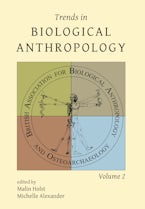The articles included in this volume were all presented at the 15th annual British Association for Biological Anthropology and Osteoarchaeology (BABAO) conference held at the University of York on the 13th and 15th of September 2013. Ten papers are presented, on a range of topics and themes, including that of ‘Constructing Identities: Ethnicity and Migration’ exploring theoretical approaches to the multiple identities of the body and multidisciplinary approaches to investigating the African origin of African American communities in parts of South America. Papers exploring the theme ‘Treatment of the Body: Understanding and Portrayals’ focus on the visibility of prehistoric burial practice in Britain and the Levant (the ‘invisible dead’), and evidence for diversity in late medieval Christian burial practice in Taunton, Somerset. Three papers are incorporated in the theme ‘Investigating Lifeways: Diets, Disease and Occupations’, focusing on ancient DNA to investigate Mycobacterium tuberculosis from 18th century mummies from Hungary; a bioarchaeological perspective on military communities in Roman London; and a methodological approach to testing a faster method for recording past activity-patterns in skeletal remains. The final three papers of the volume have both archaeological and methodological aspects, using osteological and archaeological evidence to investigate health in Roman York; exploring ostoarchaeological sampling strategies in the presentation of data from a large-scale sieving programme of a 19th century crypt and detailing a methodological study of estimating age of non-adults.
List of Contributors
Introduction (Malin Holst and Michelle Alexander)
1. Matryoshki, Masks and Identities: Bioarchaeology and the Body
Sonia Zakrzewski
2. Revisiting Genetic Ancestry in African Diaspora Communities from Atlantic South America
César Fortes-Lima and Jean-Michel Dugoujon
3. The ‘Invisible Dead’ Project: The Database as a Work-in-Progress
Mandy Jay, Chris Scarre, Charlotte Roberts, Graham Philip, Jennie Bradbury and Douglas Davies
4. Diverse Burial Practices from a Late Medieval Cemetery in Somerset
Heidi Dawson-Hobbis
5. Whole Genome Analysis of Mycobacterium tuberculosis in 18th-Century Natural Mummies from Vác, Hungary
Helen D. Donoghue, Mark Spigelman, Ildikó Pap, Ildikó Szikossy, Oona Y-C Lee, David E. Minnikin, Gurdyal S. Besra, Andrew Millard, Martin J. Sergeant, Jacqueline Z.-M. Chan, Mark J. Pallen
6. From Soldiers to Military Communities in Roman London: A Bioarchaeological Perspective
Rebecca Redfern
7. 3D Recording of Normal Entheses: A Pilot Study
Charlotte Y. Henderson
8. A Biocultural Assessment of Health in Roman York
Lauren McIntyre and Andrew T. Chamberlain
9. The Riddle of the Sands: Sieving Methodology in the Recovery of Human Remains
Don P. O’Meara
10. Biological Age Estimation of Non-Adult Human Skeletal Remains: Comparison of Dental Development with the Humerus, Femur and Pars Basilaris
Carla L. Burrell, Carole A.L. Davenport, Raymond J. Carpenter and James C. Ohman
Malin Holst is the director of York Osteoarchaeology Ltd, a commercial bioarchaeological company that carries out the excavation, analysis and reporting or publication of human skeletons from archaeological projects. She also teaches bioarchaeology at the University of York. she specializes in bioarchaeology with emphasis on osteology and palaeopathology and particular interest in weapon-related trauma from skeletal material related to battlefield sites. Her research has also focused on burial ritual, particularly on multi-period cemeteries, which often span millennia.
Michelle Alexander is Professor of Bioarchaeology at the University of York. She completed her PhD at Durham University in 2010. Her main research interests include isotopic and biomolecular analyses, food culture and multi-faith and multicultural societies in the medieval Mediterranean.











